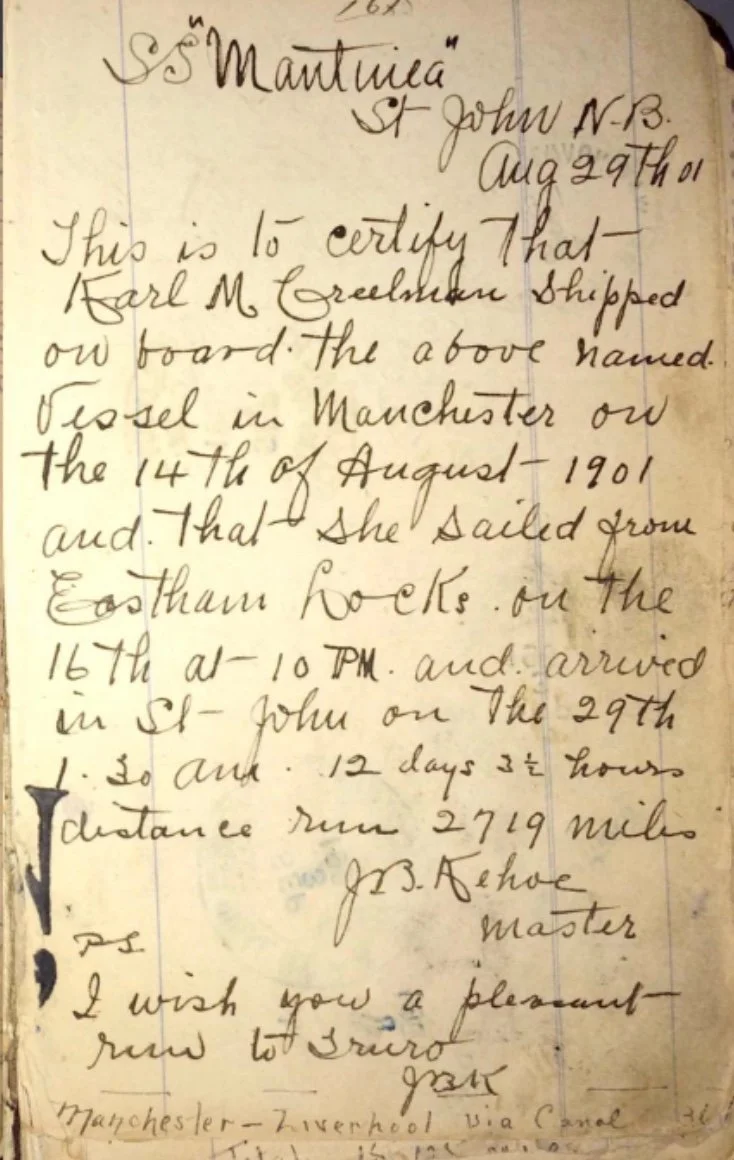Karl left Truro, Nova Scotia, on May 11, 1899, cycling across North America (through both the Dominion of Canada and parts of the U.S.), through Australia—from Victoria to Queensland—and continued his journey by bicycle through Sri Lanka, India, Egypt, Scotland, Ireland, Holland, Belgium, Germany, France, and England.
Among Karl’s documentation is a page marked “SS Mantinea”, dated August 29, 1901, Saint John, N.B. It certifies that "Karl M. Creeman shipped on board the above-named vessel from Manchester on the 14th of August 1901, and that she sailed from Eastham Locks on the 16th at 10 p.m. and arrived in Saint John on the 29th at 1:30 a.m., covering a distance of 2,719 miles in 12 days and 3½ hours."
The document is signed by J.B. Kehoe, Master, who added a postscript: "I wish you a pleasant run to Truro."
Dear reader, Karl was coming home.
The Halifax Herald reported Karl’s arrival:
“A despatch from Saint John, dated Thursday, August 29th, says:
‘Karl M. Creelman, the Truro globetrotter, arrived this afternoon from England on the steamer Mantinea, having worked his way across. It is Karl’s intention to wheel from Saint John to this town, whence he started out to wheel around the globe over two years ago. He will return on his faithful old “Red Bird”, that carried him from us in May, 1899.’”
The Saint John Sun got the first interview. The paper shared that Karl planned to leave Monday morning for home, expecting to reach Moncton that evening, Amherst by Tuesday night, and would “ride into his native town about seven o’clock Wednesday evening.”
In the interview, Karl told the journalist:
“I’m glad I started on the trip and never, during the time I was away, wished myself home.” But then he added with trademark honesty: “I would not do it all over again for a good deal.”
Karl noted some of the most challenging terrain:
The worst roads were crossing the Rockies and along the Crow’s Nest Pass.
In Queensland, Australia, three-pointed thorns wreaked havoc on his tires; he sometimes suffered six or seven punctures in a single day.
And if he had punctures in Australia, it was the hot winds of Egypt that “played havoc with the patches” on his tires.
Cycling in India, he said, was “splendid.”
In Europe, the roads were good, but heavy headwinds slowed his pace.
He recalled getting in trouble with local authorities twice:
Once in Australia, for riding along a railway track.
Once in Scotland, for failing to carry a lantern.
Financially, Karl said he ended his journey better off than when he started.
“I left Truro with three cents and promptly gave it away. They have probably increased tenfold by this time.”
The entire trip, he estimated, cost about $400 CAD, which would be approximately $15,000 today. He funded it by lecturing, selling ink, and other entrepreneurial ventures, and noted: “I generally made as I went.”
When he returned, Karl was in far better health than when he’d left. Despite being exposed to all kinds of weather, once being wet for two weeks straight, he had gained 15 pounds. “Besides his gain in experience and knowledge,” the newspaper added.
Karl’s final leg was, appropriately, the same as his first. “He will cycle by way of the Board Landing Bridge, up Prince Street to the Esplanade.”
The Truro Daily News later published this telegram:
BY TELEGRAPH: Karl Creelman in Amherst. Will be in Truro at 7 Tonight.
“Creelman, Globe Trotter, arrived from Moncton at 10 o’clock last night. He was met by H.C. MacGuchan, President of the Ramblers** Club, and many others. He left for home at 7 o’clock this morning and will arrive at Truro this evening at 7 o’clock.”
Karl left Amherst that morning and cycled the 78 miles to Truro, stopping only once—for lunch.
* Footnote: In 1917, the SS Mantinea was torpedoed by German submarine UC-63 while anchored off the Inner Dowsing light vessel station. She had been en route with coal from Newcastle, England to Genoa, Italy.
**The Ramblers bicycle club originated back in the 1890s; they rode on penny farthings and the new “safety” bicycles, the very style of Karl’s trusty Red Bird.
If you've enjoyed following Karl's journey, please consider sharing this post with others.
I've been researching and telling his story since 2016 — it's a labour of love, and every share helps keep this piece of Canadian history alive.
Then get caught up on the rest of our journey, click here for more Karl Chronicles

